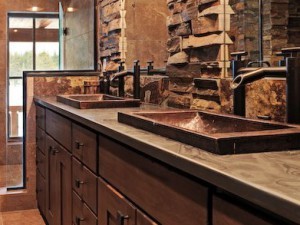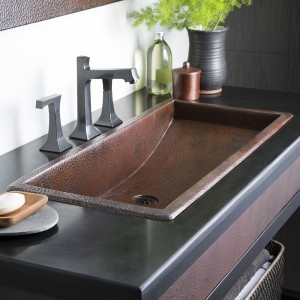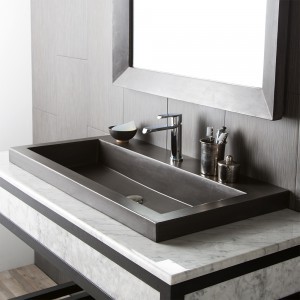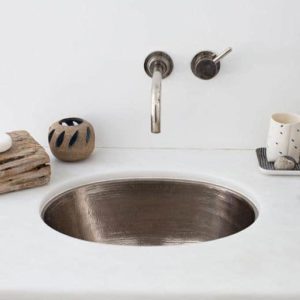Bathroom Faucets Guide
A Basic Selection Guide for Selecting the Right Bathroom Faucets for Your Space.

Sonoma Forge’s WaterBridge bathroom faucets partnered with a pair of Hana sinks.
You have innumerable options in bathroom faucets. Where to begin? Be sure to work closely with your designer or plumbing showroom specialist, who has expertise in faucet selection, and use a professional installer who follows the manufacturer’s installation guidelines. In the meantime, understand the parameters. Here are five basic tips that will help you down the right path:
TIP 1: Know your design style
Whether your bath is contemporary, modern, rustic, or anywhere in between, your bathroom faucets should complement your sink, the overall design, and the life cycle of the project.
TIP 2: Select the height
Your faucet will need to fit with the height of the sink you’ve selected. If you choose a vessel sink, for example, you’ll need a taller one than for an under mount sink. The height will affect the splash of water in and around your sink. Bonus tip: using an aerated faucet greatly reduces the splash factor AND can significantly decrease water usage.

Aquabrass’ Bridge widespread faucet has nice tall handles and a good reach, paired with Trough 30 .
TIP 3: Ensure that the spout “reach” is sufficient
The stream of water should hit pretty close to the bottom of the sink, rather than the side, to reduce splashing and provide ample space for hand washing. If your sink has a wide, exposed lip, the length of the spout is especially important. Note: Water stream does not need to hit the drain, as is sometimes mistakenly assumed; it simply should hit somewhere in the bottom area of the basin.
TIP 4: Determine the number of handles
With double handles, you’ll need both hands to adjust both handles in order to obtain the desired water temperature; with a single handle, use can use only one hand to easily obtain the desired temperature. You can also find motion or touch activated faucets with no handles at all! Decisions on faucet handles are determined both by functional as well as style preferences.
TIP 5: Select your installation or mounting type
If you are remodeling and plan to use your existing counter top, you’ll need to choose one that fits the existing hole placement and configuration.

This Graff Phase single-hole faucet – a great fit for the Trough 3619.
If this is not your situation, you have many options available. There are four standard choices:
Widespread, with two separate handles and spout measuring 8” or 16” from side to side; requires three holes. Pros: Most traditional type, best for use when replacing an existing 3-hole. Cons: Some people prefer a single handle.
Single-hole is most common in contemporary and modern design. Typically they have one integrated handle, though both dual handle and touchless faucets are also available, which have a sensor instead of a handle. Pros: Can require less drilling during installation, and can be easier to clean. Water temperature is adjusted with one movement instead of two with single handle faucets since one handle controls the flow of both hot and cold. Cons: Some people prefer a more traditional look.

California Faucets’ Avalon single handle wall-mounted faucet pairs nicely with the brushed nickel Classic.
Center set combines handles and spout on a base which measures 4” from side to side. Pros: Usually less expensive; easy installation, can cover three holes. Cons: Can look less dramatic; this is more common with lower-end options.
Wall-mounted require a separate wall-mounted valve and drain. Pros: Quite a design statement! Frees up counter space. Cons: Is usually more difficult to install and is typically a long-term commitment. These are best for new construction or a complete renovation.
Read more about selecting a faucet for a vessel sink.
